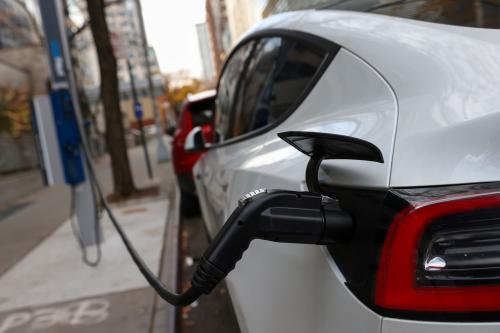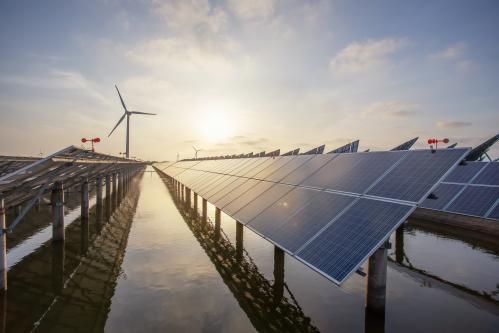Last fall and winter, as tensions increased in the Middle East and as speculation grew that the Bush administration might extend the war on terrorism into Iraq, the world’s news media began trumpeting Russia as a new power in global energy markets. In the Washington Post in December, David Ignatius claimed that Moscow is “on its way to becoming the next Houston—the global capital of energy.” By January, Russia’s President Putin had been hailed by a Canadian paper as “the world’s new oil Czar,” and the Russian media were replete with commentary on Russia’s role as the power broker in world energy markets.
The heightened media attention has raised the possibility that Russia could take on OPEC and help shift global oil supply away from the Middle East and Persian Gulf. Could Russia be poised to become an energy superpower in the 21st century? The short answer is yes, but not in the near future—and not in oil.
Russia may well break into some global energy markets as an alternative supplier to unstable states in the Persian Gulf. But Russia’s energy future is in natural gas. As the next decade unfolds, continued crises in the Middle East and growing concern about pollution and global climate change will inevitably focus attention on Russia’s vast reserves of cheaper, cleaner natural gas. Russia’s success in international gas markets, however, is not a given. It will depend on major increases in production, serious investments—both foreign and domestic—in infrastructure, and the development of fully functioning gas markets in Asia.
Petrodollars and the Russian Economy
Gas and oil have been the mainstay of the Soviet and now Russian economy for decades. Energy accounts for about half of Russian export earnings. According to Brookings economist Clifford Gaddy, “Every dollar’s increase in the price of a barrel of petroleum translates into roughly $1.5-$2.0 billion of additional yearly export revenues.” During 1999-2000, energy exports accounted for some 90 percent of Russia’s growth in GDP. Thanks to high oil prices, at the end of 2001 the economy had enjoyed its best three-year performance since 1966-69.
Russia’s oil industry slumped badly during the 1990s. As the economy contracted sharply from 1990 to 1995, domestic demand for oil fell more than 40 percent, causing a glut on the domestic market. Capacity limits in the country’s pipeline system kept lucrative oil exports down. Between 1988 and 1998, Russian oil production fell almost in half—from 11 million to around 6 million barrels a day (mbd). Drilling fell off sharply, as did investment. International investors exploring the Russian oil industry were scared away by the uncertain business climate. Russian oil seemed like a money-loser.
Russia’s August 1998 financial crisis, the devaluation of the ruble, and the subsequent—although entirely unrelated—rise in oil prices revived the industry. The devaluation drastically lowered input costs for Russian energy producers, while sharply higher oil prices boosted revenues even without new investments or production increases.
In 2001, oil companies boosted production and expanded their international reach. Russian companies are drilling for oil in Algeria, Sudan, and Libya. In 2000, LUKoil acquired a chain of gas stations along a stretch of the American East Coast and planned to strengthen its position in the United States by refining crude oil. In Eastern Europe, LUKoil acquired refineries in Ukraine, Romania, and Bulgaria; and YUKOS purchased a major stake in Transpetrol, a Slovak crude pipeline operator.
New regulatory instruments and fixed tax rates implemented by the Putin government in 2001 greatly improved the investment climate for international operators. In October 2001, Exxon Mobil announced a five-year $4 billion commitment—Russia’s largest single foreign investment to date—to its projects in Sakhalin, Russia’s energy-rich island in the North Pacific.
By the end of 2001, Russia was becoming a real international energy player. New stretches of export pipelines had been completed, and a new Russian oil terminal was operating on the Gulf of Finland. Russia concluded an ambitious agreement with the European Union on long-term energy cooperation that would increase oil exports to its neighbor. The European Union already buys more than half of Russia’s total oil exports, accounting for some 16 percent of its oil consumption.
Limits on Russian Oil
But for all its recent success, Russia will never displace OPEC in world oil markets. Over the long term, it cannot match OPEC’s oil reserves. In oil production, Russia ranks third behind Saudi Arabia and the United States, at just over 7 mbd. In exports, it ranks second, at about 4 mbd, behind Saudi Arabia with close to 7 mbd. But it ranks seventh in proven oil reserves, with only 5 percent—as against the OPEC countries’ collective 77 percent. Because of OPEC’s huge reserve base the International Energy Agency predicts that increases in world production during 2010-20 will primarily be from Middle East OPEC countries.
One sign of Russia’s reserve limits is that its recent oil industry boom was caused by increases in oil prices, not production. In fact, Russia has yet to restore production to the 11 mbd peak it reached before the collapse of the USSR. And high production costs, together with its limited reserves, will keep Russia from increasing its production capacity far beyond that point. It costs Saudi Arabia a little more than $5 to produce a barrel of oil; it costs Russia, on average, twice that.
If global recession and depressed world demand send oil prices down again, Russian oil companies could easily slide back into the troubles of the 1990s. For Russia, oil is too volatile a commodity on which to bet its entire future.
Turning Up the Gas
Will Russia fare any better with natural gas? Many in Russia’s energy complex think so, and many Russian oil companies are expanding their activities in the gas sector. Russia’s gas reserves far exceed those of any other country. Indeed, Russia is to natural gas what Saudi Arabia is to oil. With 32 percent of proven world reserves, Russia far outranks Iran (15 percent), Qatar (7 percent), Saudi Arabia and the UAE (4 percent), and the United States and Algeria (3 percent). Single-handedly, Gazprom, Russia’s giant gas company, holds a quarter of all world gas reserves, controls 90 percent of Russian output, and is Russia’s largest earner of hard currency. Its tax payments account for around 25 percent of total federal government tax revenues.
Although oil remains the dominant global fuel source, natural gas is increasing in importance. It now accounts for about 23 percent of world energy consumption and will soon displace coal (at just over 24 percent) in world markets. Increased use of liquefied natural gas and improvements in pipeline technology have transformed gas from a local commodity into an international business.
In the European Union, environmental concerns and significant local reserves have made natural gas the fastest growing energy source. Gas accounts for 22 percent of EU energy consumption (oil still accounts for 44 percent), and Russia has long been Europe’s dominant supplier. The EU buys 62 percent of Russia’s total gas exports, which in turn account for 20 percent of the EU’s overall gas consumption. Since 1997, Russia has also been Turkey’s major supplier, accounting for around 70 percent of its gas imports. The Russian government wants to increase exports to Turkey and to double exports to Europe over the next 20 years.
During the 1990s, European gas companies, including Germany’s Wintershall and Ruhrgas and Italy’s ENI, made considerable investments in Russia’s industry. Together, ENI and Gazprom are now building an underwater pipeline, the Blue Stream project, across the Black Sea to transport Russian gas to Turkey. Gazprom also intends to construct a huge trans-European pipeline from its Yamal peninsula in northwest Siberia to Germany; construct a bypass pipeline around Ukraine to avoid siphoning and illegal gas sales from the existing line; and enlist Finland in building another pipeline across the Baltic Sea from northern Russia to Germany. At the end of 2001, with record high export revenues of $14.5 billion and net profits of $3.3 billion, the future for Gazprom and Russian gas looked promising.
Northeast Asia also emerged as an important prospective market. The region already accounts for about 20 percent of world energy consumption and, over the next 20 years, may account for a third of the world’s total energy demand. China, Japan, and South Korea would like to meet that demand through increased gas consumption to mitigate the costs of pollution and dependency on Middle East oil. China is especially eager to shift from coal to gas to lessen coal’s high environmental toll. Russia’s Gazprom seems poised to tap into Asian demand. Three main gas-bearing regions—Yakutiya in Eastern Siberia, Kovytka near Lake Baikal, and Sakhalin Island—are reasonably well situated to serve Northeast Asia. Gazprom recently concluded deals with three of China’s largest companies to create a series of joint ventures.
The Caspian Basin and the Geopolitics of Russian Energy
The importance of energy to the Russian economy and Russia’s role as a major oil and gas exporter have inevitably influenced Russia’s foreign policy. In the 1990s, this was nowhere more evident than in the Caspian Basin, where rich oil and gas deposits and the growing interest and investment of U.S. and international energy companies led to sharp differences between Russia and the United States.
Russia’s oil reserves in the Caspian are smaller than those of three other former Soviet regional entities, Azerbaijan, Kazakhstan, and Turkmenistan. During the 1990s, Russia and the three smaller countries squabbled over dividing the spoils of the Caspian Sea and over the direction of new export pipeline routes. For most of the decade, Russia tried to preserve the old Soviet-era legal regime, which would have precluded the division of Caspian resources. It also fiercely resisted U.S.-backed plans to break its monopoly over existing pipelines and to transport Caspian oil across the Caucasus to Turkey.
With the discovery of larger oil reserves than anticipated in the Russian sector of the Caspian and the sudden increase in world oil prices, the Russian government became more amenable to the delimitation of the Caspian Sea. As Russian oil companies prospered, became international players, and searched for new export opportunities, they began to advocate engagement with the United States rather than confrontation in developing the Caspian Basin. In October 2001, a new pipeline to transport oil from a Chevron-led consortium in Kazakhstan to Russia’s port of Novorossiisk finally began full operation. At the end of 2001, after years of dissent, LUKoil and YUKOS indicated an interest in the U.S. government’s pet project, the Baku-Tbilisi-Ceyhan pipeline from Azerbaijan’s fields.
But Russia and the United States remain divided on other global oil issues—especially the interests of Russian energy companies in Iraq. LUKoil has a multibillion-dollar contract in Iraq to rehabilitate major oil fields once sanctions are lifted. In August 2001, Iraq reassigned rights to oil fields previously held by the French to Russia and Russian oil companies. Disagreement on Iraq, U.S. military deployments in Central Asia to support the Afghan campaign, deliberations on the postwar reconstruction of Afghanistan, and the media revival of a 1997 plan by an international consortium headed by Unocal to build a gas pipeline from Turkmenistan across Afghanistan and Pakistan to India have all heightened the sense of regional competition.
Oil was the story of the 1990s in the Caspian, but gas will be the subject in the coming decade if the focus shifts to Central Asia. The Caspian is emerging as a major new global source of gas, with the bulk of proven reserves in Turkmenistan, Kazakhstan, and Uzbekistan. Iran, second only to Russia in gas reserves, is also technically a Caspian state and has exports and greater ambitions in regional markets. Together, Russia and Iran are likely to dominate and direct Central Asian gas flows.
Russia has far more control over Central Asian gas production and exports than it does over Caspian oil. All existing pipeline routes run through Russia, and international energy companies have failed to make the same inroads into Central Asian gas production as they have in Caspian oil.
Russia and Iran will probably also predominate in South Asia. Iran has been willing to serve as a transit country for Turkmenistan’s gas and has also engaged in intensive negotiations with both Pakistan and India to export its own gas. Iran’s proposed pipelines would bypass Afghanistan and also Pakistan if necessary to access the Indian market (with a pipeline under the Persian Gulf). Gazprom is heavily involved in Iranian gas development and has made its own southern pipeline plans. Indeed, in its public announcement of priorities for 2002, Gazprom sketched out three, not two, major markets for the company: Europe, Northeast Asia, and South Asia.
An Emerging but Not Yet “Super” Energy Power
Although geopolitics seem to be working in Russia’s favor in world gas markets, the economic picture is less rosy. Gazprom’s hopes to penetrate three markets simultaneously are not likely to be realized soon, and it will need significant foreign investment to maintain even its existing exports.
Despite its huge reserves, Gazprom’s production has fallen over the past few years as Western Siberian gas fields, which account for 75 percent of current output, have depleted. In 2001, although export revenue and net profit increased, Gazprom’s exports fell 4 percent short of its 2001 targets and declined by 3 percent over 2000 volumes. As with oil, high prices—not production—have increased Gazprom revenues. Gazprom also has an estimated $11-$13 billion in debt, and over the past decade it has failed to upgrade its existing infrastructure. Only one significant new gas field has been brought on line.
Industry analysts question Gazprom’s ability to increase its exports to Europe, as well as to construct new pipelines and meet the anticipated long-term contracts with Northeast Asian countries. Gazprom, they say, will need to maintain control over Central Asian gas reserves to meet European demand—and will need huge foreign investments to realize projects in Asia. To date, Gazprom’s strategy has been to export Russian gas to hard-currency markets in Western Europe and leave Turkmenistan to supply former Soviet states like Ukraine, which have fallen behind in their energy payments to Russia. This strategy will be hard to sustain as regional states try to develop other markets and export routes. More squabbles between Central Asian states and Russia lie ahead.
In Northeast Asia, Gazprom also faces competition from other suppliers, including Australia, Bangladesh, Indonesia, and Malaysia. Even if it can provide the gas, demand is uncertain in the near term. Japan, China, and South Korea still need considerable deregulation and domestic infrastructure improvement to allow energy markets to develop. Japan lacks a domestic natural gas pipeline network and is in the midst of a financial crisis. South Korea has substantial gas infrastructure in place, but its market is too small to justify building overland pipelines from Russia through China and North Korea. China lacks the infrastructure for major domestic gas usage and still needs transportation and urban distribution networks.
While Russia is an important player in world oil markets—especially in Europe—it cannot compete with or displace the Middle East and other OPEC countries over the long term. Changes in global energy consumption and increasing efforts to find alternatives to both oil and coal make gas the resource of the future. Russia’s gas reserves are immense and, as yet, not fully developed. Its geopolitical location straddling Europe and Asia, with gas fields stretching from west to east Siberia and the island of Sakhalin, gives Russia unique reach. With significant foreign investment, improvements in production, and the construction of pipelines and other infrastructure, Russia will be able to respond to growing demand for natural gas. Having already made considerable inroads in European gas supplies, it will likely begin to tap into Asian markets in the coming decade. In 2002, Russia is an emerging energy power. It may yet be an energy superpower in the next 20 years.



Commentary
Russia: The 21st Century’s Energy Superpower?
March 1, 2002